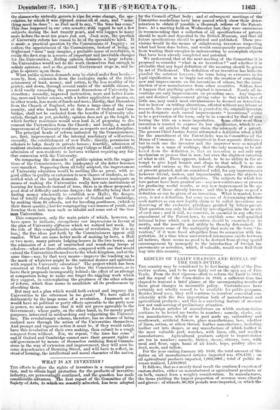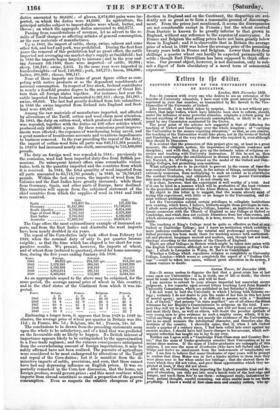RESULTS OF TARIFF CHANGES AND REPEAL OF THE CORNIDITTIES.
Tax country may be considered to" be fast losing sight of the Pro- tectivesystem, and to be now fairly out on the open. sea of Free Trade. From the first vigorous effort to reform the Tariff in 1842, and the repeal of the Cornecluties in 1846, a sufficient time has elapsed to warrant a brief glance at the accompanying results of these great changes in mercantile policy. Customhouses have certainly not wholly ceased to be available for public purposes. .. Besides fiscal uses, they still continue to interfere somewhat-con- siderably with the free importation both of manufactured and agricultural products ; and 'this is a surviving featare of revenue
law not undeserving of preliminary attention. .
The foreign articles of manufacture- on widish eustom-duties continue to be levied are twelve in number • namely, clocks, cot- ton manufactures, wholly or in part made up, embroidery and needlework, artificial flowers, glass manufactures, lace, whether • of linen, cotton, or silken thread, leather manufactures, including - leather cut into shapes, or any manufacture of which leather is the most valuable part, watches, with linen, 'silk, and woollen manufactures. Agricultural products subject to import-duties ' are ten in number ; namely, butter, cheese, chicory, corn, with meal and flour, eggs, hams of all kinds, hops, poultry alive or dead, seeds, and tallow.
For the year ending January 5th 1-850, the total amount off the , duties on all manufactured articles imported was 474,476/. ; on all agricultural products imported, 1;062,5061. ; total of pnblio re- venue realized, 1,538,9821.
It follows, that as a merely fiscal result the continued exaction of custom-duties, either on manufactured or agricultural products or on both, cannot form a weighty consideration. In -manufactures, the items yielding the largest proportion of revenue were ribands and gloves : of ribands, 96,524 pounds were imported, on whielfthe -• duties amounted to 59,6581. ; of gloves, 2,874,695 pairs were im- ported, on which the duties were 44,0591. In agriculture, the principal articles subject to import-duties were wheat, butter, and cheese ; on which the aggregate duties amounted to 462,8771. Passing from considerations of revenue, let us advert to the re- sults of Tariff changes as affecting articles of general consumption, or the raw materials of manufactures. Up to 1842, the import of cattle, sheep, swine, salmon and some other fish, and beef and pork, was prohibited. During the first four years the removal of this prohibition had no great effect, the cattle imported not averaging one market-day's supply at Smithfield ; but in 1846 the imports began largely to increase ; and in the year end- ing January 5th 1850, there were imported—of cattle, 39,804 ; sheep, 126,248; swine, 2,653. In the same year were imported in hundredweights—of beef, 149,962; pork, 348,275; bacon, 384,696; butter, 281,969; cheese, 390,147. None of these imports are items of great figure either as com- peting with native products or as the dependent constituents of national consumption. In respect of live stock, Ireland contributes in nearly a fourfold greater degree to the sustenance of Great Bri- tain than all foreign states together. For instance, last year the cattle imported from Ireland amounted to 201,811; sheep, 241,061 ; swine, 68,053. The last had greatly declined from late calamities; in 1846 the swine imported from Ireland into England and Scot- land were 480,827.
Among the raw materials of manufacture imported, and affected by alterations of the Tariff, cotton and wool claim most attention. in 1845, the duty on cotton-wool, which produced about 680,0001., was repealed, together with the duties on 430 other articles which produced only 320,0001. a year. By these remissions great improve- ments were effected; the expenses of warehousing being saved, and a great numberof troublesome accounts and vexatious impediments to business removed. In the year preceding the repeal of the duty, the import of cotton-wool from all parts was 646,111,304 pounds ; in 1849 it had increased nearly one-sixth, amounting to 755,469,008 pounds.
The duty on foreign wool was repealed. in 1844 ; previously to the remission, wool had been imported duty-free from British pos- sessions. Its subsequent history offers some remarkable vicissi- tudes, both in the quantity imported and the countries from which it is received. In 1844, the total quantity of wool imported from all parts amounted to 6,5,713,761 pounds ; in 1849, to 76,768,647 minds. Within the last six years, the imports of wool from the Colonies and the East Indies have greatly increased; while those from Germany, Spain, and other parts of Europe, have declined. This transition will appear from the ,subjoined statement of the chief countries from which the supplies of wool in 1844 and 1849 were received.
Spain Germany. South America Cape of Good Hope .. East Indies Australia
Australia
1844. 21,847,684 3,760,063 2,197,143 2,765,853 17,602,247
Spain 918,853 lbs. 127,669 lbs. Germany. 21,847,684 12,750,011 South America 3,760,063 • •4 6,014,525 Cape of Good Hope .. 2,197,143 5,379,495 East Indies 2,765,853 4,189,171
918,853 lbs.
• •4 12,750,011 5,379,495
4,189,171
36,87
1844. 1849.
17,602,247 36,87 1849. 127,669 lbs.
6,014,525 2,853
2,853
The Cape offers the most extraordinary example of increased ex- ports, and from the East Indies and Australia the wool imports have been nearly doubled in six years. The repeal of the Corn-duties only took effect from Februry 1st 1849, when the nominal duty of only ls. per quarter became exigible ; so that the time which has elapsed is too short for com- parative results. We present, however, the imports of wheat, and of wheat-flour (reduced to quarters), cleared for home consump- tion, during the five years ending January 5th 1850.
Colonial.
23t223 qrs 418;519 181,141 172,302 Colonial. Total.
23t223 qrs 313,244 qrs. 418;519 4,612,111 181,141 2,193,755 172,302 5,634,344
Total. 313,244 qrs.
2,943,926 4,612,111 2,193,755 5,634,344
2,943,926 duction in England and on the Continent, the disparities are evi- dently not so great as to form a reasonable ground of discourage- ment. From the prices just mentioned, it seems the discrepancies are not considerable except in Prussia ; but the wheat received from Dantzic is known to be greatly inferior to that grown in England, without any reference to the expense of conveyance. In France and Belgium the selling prices have not been greatly below those in England; and it is observable that in Britain the average price of wheat in 1840 was below the average price of the preceding twenty years both in France and Belgium. Lower than forty-four shillings a quarter wheat can hardly be expected permanently to settle ; though Earl Fitzwilliam has been supposed to think other- wise. Our present object, however, is not discussion, only to sub- mit a digest of Fads elucidatory of a novel term of commercial experience.

























 Previous page
Previous page